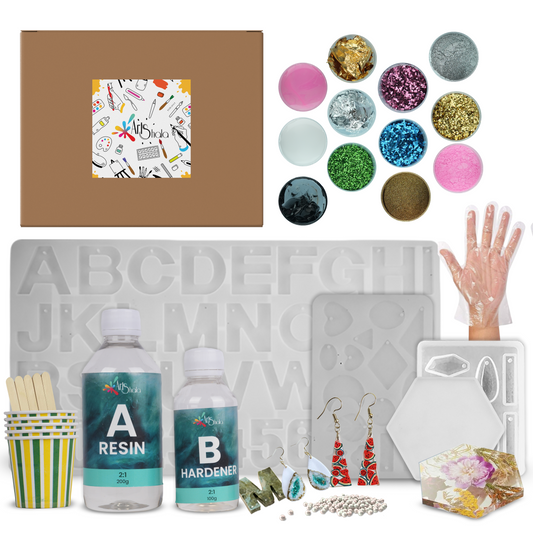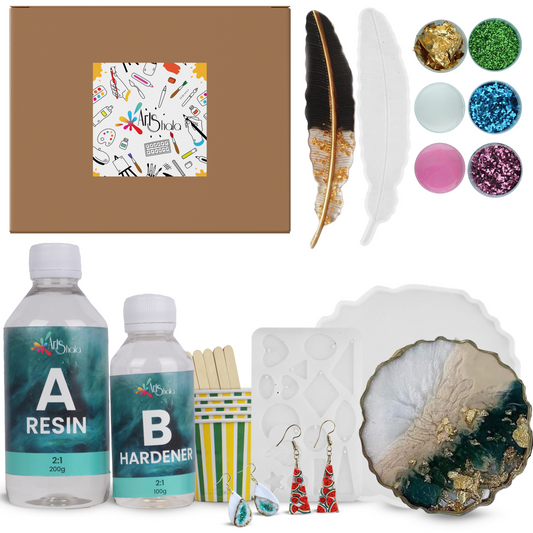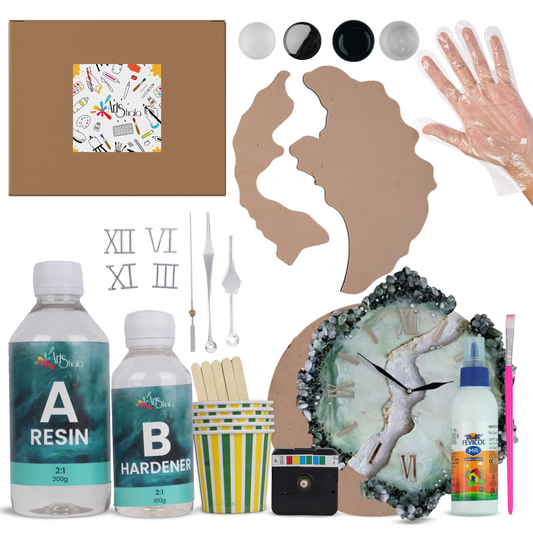A Guide to DIY Resin Phone Cases
DIY resin phone case offers the perfect solution. This trendy technique transforms a simple case into a stunning work of art, reflecting your style. However, working with resin requires specific knowledge and careful execution. Fear not, creative minds! This comprehensive guide will provide you with all the information needed to embark on your resin phone case journey, from gathering materials to achieving a flawless finish. To learn more about such amazing projects, enrol in a resin art workshop.
Safety First: Essential Precautions
Resin, while versatile, demands a safety-conscious approach. Here are some crucial precautions to remember:
- Work in a Ventilated Area: Resin fumes can irritate the respiratory system. Open windows and consider using a respirator for added protection.
- Protect your skin: Wear gloves throughout the process to prevent skin contact with resin.
- Eye Protection is Critical: Safety goggles shield your eyes from accidental splashes.
- Cover Your Workspace: A newspaper or a plastic sheet safeguards your work area from spills.
- Dispose of Materials Responsibly: Follow recommended guidelines for disposing of resin, gloves, and other used materials.
Steps to Make a DIY Resin Phone Case
Now, let's assemble the tools you'll need to create your masterpiece:
- Clear phone case: Choose a case compatible with your phone model. A clear, flexible case made of TPU (Thermoplastic Polyurethane) is ideal. Avoid silicone cases, as the resin may not adhere well.
- Crystal Clear Casting Resin: Ensure the resin is suitable for casting applications. Opt for a brand known for quality and follow the manufacturer's instructions for mixing ratios and cure times.
- Resin Colourants (Optional): Explore a world of colours to create vibrant effects. Look for pigments designed explicitly for resin use.
- Disposable Mixing Cups: Allocate separate cups for mixing resin and colouring it (if desired).
- Resin Mixing Sticks: These stir sticks are ideal for mixing resin without introducing air bubbles.
- Droppers or Syringes (Optional): These tools facilitate the precise application of coloured resin or small decorative elements.
- Masking Tape: Seal any openings on the phone case to prevent resin leakage.
- Sandpaper (Optional): Fine-grit sandpaper can smooth the phone case surface for better resin adhesion (ensure you clean the case thoroughly afterwards).
- Alcohol Wipes: Clean and prep the phone case before applying resin.
- Level Surface: A flat surface is essential for a flawless resin pour.
- Optional Embellishments: Let your creativity flow! Dried flowers, glitter, metallic flakes, small photos, or seashells can personalise your case. Ensure they are dry and clean before embedding them in resin.
- Mould Release Spray (Optional): This can help prevent the cured resin from sticking to your work surface.
- Heat Gun (Optional): A heat gun can help release air bubbles from the resin after pouring. Use caution and follow the instructions for safe heat gun operation.
- Nitrile Gloves: Wear gloves throughout the process to protect your hands.
- Safety Goggles: Eye protection is vital to prevent splashes.
- Respirator (Optional): Consider using a respirator for additional protection from resin fumes, especially if you have respiratory sensitivities.
Preparing Your Workspace
- Choose a Well-Ventilated Area: Open windows and ensure proper air circulation.
- Cover Your Workspace: Lay newspaper or a plastic sheet to protect your work surface.
- Gather Your Supplies: Lay out all the materials you'll need within easy reach.
- Clean and Dry the Phone Case: Use an alcohol wipe to thoroughly clean the phone case, removing any dirt, dust, or oils that might hinder resin adhesion.
Mixing the Resin
- Consult the manufacturer's instructions: For optimal results, every resin brand has specific mixing ratios. Carefully follow these instructions to ensure sound curing and avoid a sticky mess.
- Measure accurately: Use measuring cups or syringes to precisely measure the required amounts of resin (Part A) and hardener (Part B). Even tiny variations can affect the curing process.
- Mix thoroughly: Pour the measured parts into a clean, disposable mixing cup. Slowly and gently stir the mixture using a resin mixing stick for several minutes. Scratch the sides and bottom of the cup to ensure all components are fully incorporated. 4-5 minutes of slow, steady mixing is recommended to minimise air bubbles.
Colouring the Resin (Optional)
- Separate a Small Portion: Pour a small amount of the mixed resin into a separate disposable cup. This portion will be used for colouring.
- Add Colourants Sparingly: Start with a tiny pigment and slowly add more until you achieve the preferred colour intensity. Remember, a little goes a long way with resin colourants. Over-colouring can affect the resin's curing process and clarity.
- Thorough Mixing is Key: Once you've added the colourant, stir the separate cup gently for several minutes to ensure an even distribution of the colour throughout the resin.
Preparing the Phone Case
- Apply Masking Tape (Optional): If your phone case has any cutouts for buttons or the camera, use masking tape to seal these openings and prevent resin leakage. Ensure the tape adheres well to the case.
- Consider Sanding (Optional): Lightly sand the phone case surface with fine-grit sandpaper for better resin adhesion. Clean the case thoroughly with an alcohol wipe to remove any dust created by sanding.
Assembling Your Creation
- Position the Phone Case: Place the phone case on a level surface lined with newspaper or a plastic sheet. Ensure it's positioned with the back facing up and ready for the resin pour.
- Prepare Your Embellishments (Optional): If incorporating decorative elements, arrange them carefully inside the phone case. Use tweezers for precise placement. Leave enough space between the embellishments to allow the resin to flow freely.
Pouring the Resin
- Work Slowly and Steadily: Slowly pour the mixed resin (clear or coloured) onto the centre of the phone case. Avoid pouring directly onto the embellishments, as this can displace them.
- Tilt the Case for Even Distribution: Gently tilt the case from side to side, allowing the resin to flow evenly and cover the entire back surface. Use a toothpick or resin mixing stick to nudge the resin and ensure it reaches all corners and edges.
- Removing Air Bubbles: They get trapped in the resin and can create imperfections. Here are two methods to address them:
- Heat Gun (Optional): Carefully use a heat gun on the lowest setting to gently heat the resin's surface. The heat will help air bubbles rise to the surface, where they can be popped with a toothpick. Caution: Move the heat gun constantly to avoid overheating the resin.
- Dropper or Syringe (Optional): For stubborn bubbles, use a dropper or syringe to apply a tiny amount of clear resin directly onto the bubble. This will typically cause the bubble to burst.
- Adding a Second Layer (Optional): If your phone case has a deep profile or you desire a thicker resin layer, pour a second layer after the first layer has partially cured (usually around 30 minutes, following the resin manufacturer's instructions). Repeat steps 1-3 for the second layer.
Curing and Finishing Touches
- Allow for Curing: Set the phone case aside in a well-ventilated area, free from dust and direct sunlight. Refer to the resin manufacturer's instructions for specific curing times. Most resins take 24-48 hours to cure fully.
- Removing Masking Tape: Once the resin has cured completely, gently peel off any masking tape that covers the phone case's openings.
Optional Polishing
You can lightly buff the cured resin surface with a soft polishing cloth for an extra shine. However, avoid using abrasive materials that might scratch the resin.
Congratulations! You've successfully crafted a one-of-a-kind DIY resin phone case. Now, you can showcase your creativity and protect your phone in style.
Additional Tips to Make a DIY Resin Phone Case
- Start with a Simple Design: For your first attempt, consider a clear resin case with minimal embellishments. As you gain experience, you can experiment with more intricate designs and techniques.
- Practice Pouring Techniques: Before working on your phone case, consider pouring resin on a disposable surface like a plastic sheet to get comfortable with the flow and consistency.
- Less is Often More: When adding embellishments, avoid overcrowding the design. A few well-placed elements can create a more visually appealing and balanced outcome.
- Let your Imagination Run Wild!: The beauty of DIY resin projects lies in their limitless customisation potential. Explore different colour combinations, experiment with various embellishments, and create a phone case that reflects your unique style.












